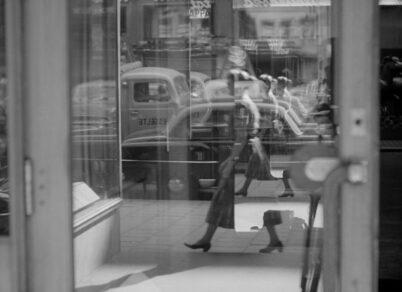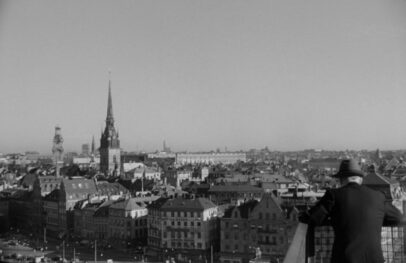 A morning in 1950s Stockholm, on “any day, the 6th of June, for example.” As absurdly high-spirited music plays, blandly optimistic narration offers tourist bureau-worthy superlatives—“Is there a city more beautiful than our capital of Stockholm?”—over documentary footage of the royal palace, city hall and a military parade. It would seem we’re viewing what would now be termed an “essay film” of a type that was especially popular in the 1920s, in the form of MANHATTA (1921), BERLIN—SYMPHONY OF A GREAT CITY/Berlin—Sinfonie einer Großstadt (1927) and THE MAN WITH A MOVIE CAMERA/Chelovek s kino-apparatom (1928).
A morning in 1950s Stockholm, on “any day, the 6th of June, for example.” As absurdly high-spirited music plays, blandly optimistic narration offers tourist bureau-worthy superlatives—“Is there a city more beautiful than our capital of Stockholm?”—over documentary footage of the royal palace, city hall and a military parade. It would seem we’re viewing what would now be termed an “essay film” of a type that was especially popular in the 1920s, in the form of MANHATTA (1921), BERLIN—SYMPHONY OF A GREAT CITY/Berlin—Sinfonie einer Großstadt (1927) and THE MAN WITH A MOVIE CAMERA/Chelovek s kino-apparatom (1928).
But about two minutes in a man is seen climbing onto the railing atop a building, apparently to jump off, and then, roughly three minutes in, a ship sinks in the Stockholm harbor. This is followed by much fractured and repetitious imagery, intimating that the narrator is wrong, and that there’s something deeply wrong in this seeming paradise.
Around the four-minute mark the narration cuts off and a man named Nordlöv-Berglund (Per-Olov Ultvedt) reports to the Central Statistical Office. He wants to change his name (because he “might have got the wrong one”) to a new moniker that sounds like “the movement of swirling swallows,” but is denied.
Pontus Hultén & Hans Nordenström: En dag i staden (1956, 2 min excerpt) from Filmform on Vimeo.
Outside the office police chase a man through city streets and up the sides of walls, and we’re shown a POV drive through city streets at impossible speeds (with the scenery abruptly switching from Stockholm to that of Paris). Inevitably the city is destroyed in a riot of fire, explosions, cars driving off a bridge and a smoking fire truck that’s reduced to a smoldering rubble.
This 19-minute film was a product of the Working Group for Film, a Swedish consortium that turned out avant-garde classics like THE WHITE HANDS/De vita händerna (1950) and SYCADORA (1951). A DAY IN THE CITY/En Dag I Staden (1956) was made by the Working Group members Pontus Hultén and Hans Nordenström, who crudely but effectively integrate the plainly unreal, in the form of animation and staged drama, into verité footage depicting the citizens of a bustling metropolis going about their daily business.
Jump cuts are common, as are varying film speeds, frantic montage editing and a soundtrack that juxtaposes the actual sounds of downtown Stockholm with a jumble of nonsensical conversations and fractured music cues. The filmmakers make no attempt to hide their presence, as when a voice is heard scolding passerby to “Watch out for the camera!”
A variety of influences are evident, including (as previously stated) the 1920s City Films and the cinema of Luis Bunuel and René Clair. You’ll also find plenty of foreshadowing, including Claude Lelouch’s RENDEZVOUS (1976) and any number of Monty Python skits, but A DAY IN THE CITY’s mixture of satire and Dadaist subversion remains distinct.
Claude Lelouch’s RENDEZVOUS Trailer (1976)
Vital Statistics
A DAY IN THE CITY
Kasark Film/Europafilm
Directors/Cinematography: Pontus Hultén, Hans Nordenström
Screenplay: Gösta Winberg, Hans Nordenström, K.G Hultén
Cast: Per-Olov Ultvedt, Oscar Reutersvärd, Jean Tinguely, Haide Göranson, Pontus Hultén

